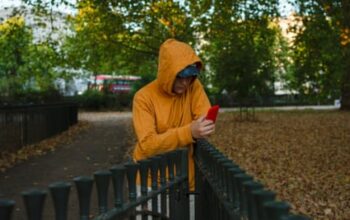
The NSPCC has reported a 25% increase in crimes related to child abuse imagery (CAI) over the last year.
Nearly half of those incidents where the platform was recorded occurred on Snapchat, while Meta’s family of apps, including Facebook, Instagram and WhatsApp, covered another 26%.
According to records obtained through 35 police forces across the nation, over 33,000 crimes involved the collection and distribution of CAI in a single year.
Peter Wanless, the CEO of the NSPCC, expressed concern about the increasing rates of online child abuse. He believes that technology companies should proactively ensure the safety of their websites, rather than waiting for regulations to enforce it.
“Adults who are able to easily coordinate and distribute sexual abuse across social media and messaging apps have specifically targeted and manipulated children to carry out these heinous acts.”
The numbers signify a significant rise in the past five years. In the initial investigation conducted by NSPCC in 2017-18, data for nearly 18,000 offenses were provided by forces, while in the previous year, the total had only surpassed 25,000.
The nonprofit organization stated that the rising number of child abuse imagery (CAI) shared on the internet is a result of the increasing demand and accessibility for such materials. Susie Hargreaves, the CEO of the Internet Watch Foundation (IWF), emphasized that those who view, share, and distribute this material must understand that it is not a victimless act. The victims are real children who have experienced serious abuse and trauma, which can have lasting impacts on their lives. The IWF collaborates with technology companies and law enforcement to promptly remove CAI from online platforms.
According to data collected by the IWF in the previous month, the organization revealed that 90% of the webpages it flagged for CAI (Child Abuse Imagery) contained “self-generated” images. These images were taken by the person depicted in them, usually under coercion. Over 100,000 webpages were identified to contain self-generated CAI of children under the age of 10, although some pages may have shown the same image.
According to a representative from Snapchat, the company condemns child sexual abuse and does not allow it on their platform. They utilize advanced detection technology to locate and delete this type of material, and collaborate with law enforcement in their efforts. In addition, Snapchat has implemented additional safety measures for minors aged 13-17, such as warning pop-ups if they receive messages from unfamiliar individuals.
The spokesperson reported an increase in the company’s ability to detect content, up from 94% to 98% within the past year.
The NSPCC issued a warning that the numbers of detected child abuse imagery cases are expected to decrease as Meta plans to implement end-to-end encryption for direct messaging on Instagram and Facebook Messenger. It urged for a delay in the further rollout of this feature until Ofcom has had the chance to review Meta’s risk assessment, as per the new regulations introduced by the Online Safety Act passed last year.
-
.
The NSPCC provides assistance to children at 0800 1111 and to concerned adults at 0808 800 5000 in the United Kingdom. Adult survivors can seek support at 0808 801 0331 through Napac. In the United States, the Childhelp abuse hotline can be reached by calling or texting 800-422-4453. In Australia, those in need of support can reach out to the Kids Helpline at 1800 55 1800 for children, young adults, parents, and teachers or the Blue Knot Foundation at 1300 657 380 for adult survivors. Additional resources can also be found through Child Helplines International.
Source: theguardian.com



